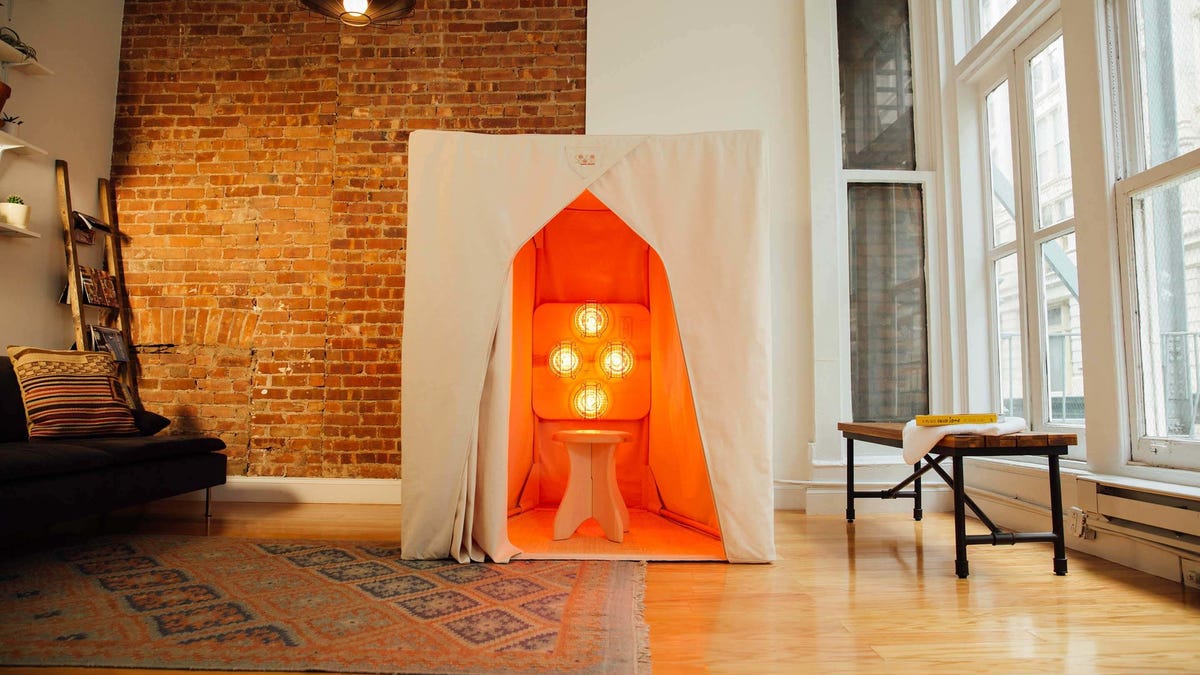 Why You Can Trust CNET
Why You Can Trust CNET Far-infrared therapy: The cure for muscle aches?
Find out if a pair of $100 pajama pants is worth it.

Could this personal infrared tent be the cure to your achy joints?
From whole-body cryotherapy to inflatable compression boots, people certainly take extensive measures to keep their bodies in tip-top shape. Oh, and let's not forget about punching your muscles with massage guns that sound like power drills.
The latest in workout recovery? Sleepwear manufactured with bioceramic particles that reflect far-infrared radiation into your body as you rest.
When you're a professional athlete like six-time Super Bowl winner Tom Brady, I suppose special far-infrared pajamas aren't actually far out of reach, and every new innovation is worth trying. But does his Under Armour sleepwear line actually work? This article covers the claims about far-infrared therapy and whether they're all backed up by science.
Under Armour's bioceramic sleepwear and bedding looks just like regular sleepwear and bedding, but the products use far-infrared technology to promote muscle recovery overnight.
What is far-infrared therapy?
Brace yourself for some science: Far-infrared therapy uses far-infrared radiation, which refers to a subdivision of the electromagnetic spectrum.
Infrared is a type of light that humans can't see, but can feel as heat. "Far" describes where the wavelengths fall on the light spectrum.
Perhaps the easiest way to grasp the concept of FIR therapy is to compare regular saunas to FIR saunas.
Regular saunas use heat to warm the air in an enclosed space, which in turn warms your body. People love saunas because of the benefits of heat therapy, which include reduced muscle pain and relaxation.
FIR saunas, on the other hand, use light instead of heat. These far-infrared light waves heat your body directly without the need to heat the air around you. Apparently, FIR light can transfer energy purely in the form of heat and reach deeper layers of body tissue, which is why FIR is the light of choice for bodily therapy.
Additionally, FIR therapy offers the same benefits as heat therapy without the intense heat, which is why companies are putting it into everyday products -- like pajamas, bed sheets and even panty liners.
How does far-infrared therapy work?
FIR heat lamps, saunas and strange personal tent-like contraptions emit far-infrared light directly onto your body, where it reaches depths of 2 to 3 centimeters (about an inch) beneath the surface of your skin. Your body absorbs the light, which kickstarts a series of physiological reactions.
When it comes to FIR clothes, bedding and personal care products (like these FIR panty liners), your body actually initiates the work.
Since human bodies tend to be at higher temperatures than the surrounding air indoors, research suggests that the FIR emission originates from your body and interwoven bioceramic particles in the products re-emit the energy back into your body.
What are the benefits?
The supposed benefits of FIR therapy include benefits similar to those of regular heat therapy:
- Relaxation
- Better sleep
- Improved blood flow
- Muscle recovery
- Relief from joint pain
- Improved range of motion
Plus some others that seem a little more questionable:
- Detoxification
- Weight loss
- Improved complexion
Unlike traditional saunas, which heat up the air around you, far-infrared saunas use light to directly heat your body. For most people, this results in less sweating.
What does the science say?
Overall, research on FIR therapy seems promising, but there's a long way to go.
There is little evidence regarding FIR's effects on weight loss. One study reports reduced body measurements after wearing bioceramic clothing. A massive review of FIR studies, however, cites this same study as the only weight-loss trial, so this concept definitely needs more research.
I also didn't find any studies related to far-infrared and detoxing, improved skin or improved sleep.
There is, however, plenty of research related to pain relief and overall health:
- A 10-person study found that use of an infrared sauna as part of an overall treatment plan helped people with chronic fatigue syndrome.
- One review that gathered information from several studies suggests that infrared light therapy saunas may help reduce blood pressure.
- Infrared saunas may temporarily relieve joint pain and improve range of motion in people with arthritis. FIR may also help people maintain bone health.
- Bioceramic shirts may relieve pain in patients with fibromyalgia.
- Infrared waistbands seem to be effective at reducing chronic lower back pain.
- Another 10-person study found that infrared saunas can speed up muscle recovery after strength-training sessions.
- Some promising research suggests that FIR clothing may alleviate muscle soreness after physical activity, or at least the perception of muscle soreness.
- FIR might have protective effects against several chronic diseases, including cardiovascular disease.
- And, just because it's worth knowing, one study found FIR therapy to significantly improve allergy symptoms.
Should you try it?
In my opinion, we need more large-scale studies to really understand if FIR therapy really induces its supposed benefits, particularly for weight loss and improved sleep. In the meantime, it's up to you to decide if a $100 pillowcase is worth it.
If nothing else, sitting in saunas can be relaxing -- I'd recommend trying a FIR sauna before investing in bioceramic clothing or bedding. Many gyms and health clubs offer FIR saunas for members, so check with member services if you're interested. If yours offers a "dry sauna," that's the same thing: It's a nickname given to FIR saunas because you won't sweat as much as you would in a traditional sauna.
But if you're just looking to treat sore muscles and this all sounds a little questionable to you, you can always try submerging your body in subzero temperatures or suiting up in inflatable boots.
Or you can stick to good old-fashioned stretching and foam rolling.

